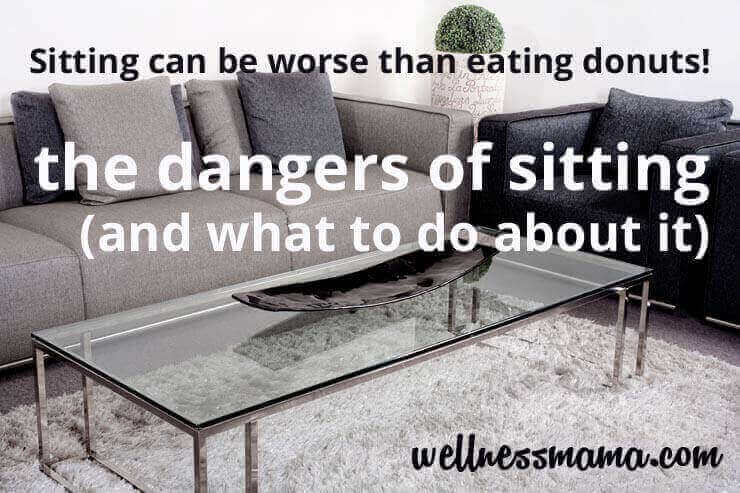If you knew how much I dislike donuts you’d understand how strong of a statement that is for me. Donuts are a mixture of three of the worst non-foods available: processed grains, hydrogenated vegetables oils and sugar. They have no nutritional value (unless you’re eating healthy homemade ones) and can harm your health in a variety of ways. And sitting too much can be worse.
The Problem With Sitting
Sitting is more dangerous than smoking, kills more people than HIV and is more treacherous than parachuting. We are sitting ourselves to death. – Dr. James Levine of the Mayo Clinic
Dr. Levine further explains that sitting not only increases the risk obesity, but also the risk of cancers (like lung, endometrial, breast and prostate), heart disease, hypertension, diabetes and more.
His research and an analysis of many recent studies show that each hour we spend sitting takes about 21 minutes off of our lives (smoking only shaves 11 minutes off of your life. The jury is still out on how many minutes each donut takes away).
Here are some of the reasons why:
- We burn 50 less calories per hour when sitting (compared to standing)
- Sitting can cause the muscles to atrophy or tighten in certain places and lead to things like back pain
- Research is also showing that sitting for long periods causes the muscles to release less of the enzyme Lipase which controls proper breakdown of fats
- Sitting for long periods can reduce insulin sensitivity and increase risk of insulin resistance
- Sitting too much for an extended time can reduce bone density
Chris Kresser sums it up:
Even worse, too much sitting could shorten your life. Studies in the U.S., Canada, Australia and Asia have all found an association between increased sedentary time and the risk of early death. (6, 7, 8, 9) These associations were independent of traditional risk factors such as smoking, blood pressure, cholesterol levels, waist circumference and diet.
Does Exercise Help?
What I found most interesting about the research on sitting is that the statistics remained true even if the person being studied exercised for the recommended amount each day. In other words- exercise doesn’t mitigate the harmful effects of sitting.
Even marathon runners and elite athletes who trained for hours a day but sat for the rest of their day were at risk because it was the act of sitting that caused the problem, not the lack of exercise.
This makes it important to modify our home and office environments to reduce the amount of time we spend sitting in the first place. I cover all desk chair options I’ve tried in this post, but which alternatives to sitting are really healthiest?
Is Standing Better?
One solution often offered to help avoid the harmful effects of sitting is to use a standing desk instead. I personally do this and notice that I am much more productive since making the switch.
Switching to standing for even just part of your day (3-4 hours) burns an extra 1000+ calories a week, which works out to the calories burned from running over 15 marathons when done for a year.
Reducing the amount of time spent sitting for even a few hours a day also drastically lowers the risk of the diseases associated with a sedentary lifestyle. It isn’t a perfect solution, but it is a step in the right direction.
I personally have this standing desk which I found for under $200 and it has lasted me several years and is still in great shape. I keep it in the corner of a room and it actually takes up less space than a conventional desk. Another unexpected benefit: my little kids can’t reach the top of my standing desk, so it is one of the few safe places in the house I can keep my camera or other delicate equipment.
While standing is a better solution, it has some downsides as well, including a higher risk of back strain and varicose veins.
A Step Up from Standing
Switching to a treadmill desk is another solution that offers even better benefits than just standing. It is cost and space prohibitive for many people, but it seems to be the best desk-optional available.
I don’t have one yet, (trying to convince myself we CAN fit one in our house!) but will definitely share my experience if/when I do. Typically a person walks very slowly on a treadmill desk (less than 2 mph) which is enough to get blood flowing without making it difficult or distracting to work.
I am planning to get a basic treadmill like this one to add to my standing desk. Another great option would be to find a used treadmill on Craigslist or a similar site (I’ve seen them for under $200 often) and build a simple desk to go around it.
The Best Solution
In a perfect world, the best solution would be to use a treadmill desk that encourages slow movement and also to take breaks at various intervals for some more specific movements.
A treadmill desk isn’t an option for many of us, so another great solution is to do some very specific short exercises for 2-5 minutes after every hour or so of sitting. I recently interviewed two physical therapists who specialize in exercises to counteract the negative effects of sitting, and they explain this in detail in this podcast episode.
Long story short, sitting kills and over the long term it can be worse for your health than smoking or eating donuts.

How much do you sit per day? Think about all the time you spend driving, working at a desk, watching TV, etc. It’s probably more than you think (it was for me!). Share below!


Leave a Reply